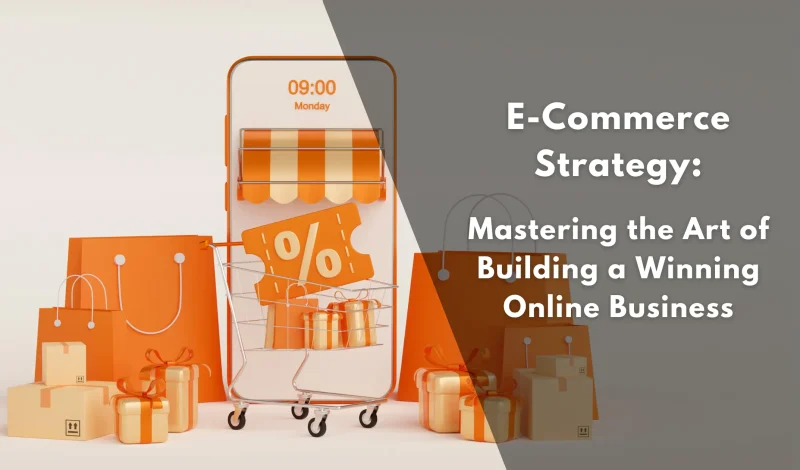In today’s rapidly evolving digital landscape, e-commerce has become an essential component for business success. Whether you’re running a small boutique or a large enterprise, a robust E-Commerce Strategy can significantly enhance your reach, boost sales, and foster brand loyalty. This guide will provide you with a comprehensive blueprint for developing an effective E-Commerce Strategy tailored to your business needs.
The Importance of an E-Commerce Strategy
An E-Commerce Strategy is more than just setting up an online store; it involves a holistic approach that integrates various business elements to create a seamless online experience. This strategy includes product selection, website design, digital marketing, customer service, and logistics. Without a coherent strategy, you risk inefficient use of resources and missing out on potential revenue opportunities.
Step-by-Step Guide to Developing Your E-Commerce Strategy
1. Analyze Your Industry and Market
Before launching an E-Commerce Strategy, it’s crucial to understand the dynamics of your industry and market. This involves a thorough analysis of competitors, market trends, and customer behavior.
Market Research Steps:
- Competitor Analysis: Examine your competitors’ websites to understand their product offerings, pricing strategies, and customer engagement tactics. Tools like SEMrush and Ahrefs can provide valuable competitive insights.
- Customer Insights: Gain a deep understanding of your potential customers’ needs, preferences, and shopping habits. Surveys, focus groups, and social media listening tools can offer valuable data.
- Trend Analysis: Stay updated with the latest industry trends by following industry publications, and blogs, and attending webinars and trade shows. Identify emerging trends that can help you stay ahead of the competition.

2. Define Your Business Goals
Clear, specific goals are essential for a focused and effective E-Commerce Strategy. These goals can include increasing brand awareness, boosting online sales, expanding into new markets, or enhancing customer satisfaction. Measurable objectives help track progress and make necessary adjustments.
Setting SMART Goals:
- Specific: Clearly define what you aim to achieve.
- Measurable: Ensure your goals can be tracked with quantifiable metrics.
- Attainable: Set realistic goals based on the resources you have.
- Realistic: Align your goals with your overall business goals.
- Time-bound: Set a deadline to achieve your goals.
3. Identify Your Target Audience
Understanding your target audience is crucial for creating a tailored e-commerce experience. Consider demographic factors such as age, gender, location, and psychographic factors like interests, values, and behaviors. This information will help you design a website that appeals to your audience and meets their needs.
Creating Buyer Personas:
- Demographic Information: Age, gender, income, education, and occupation.
- Psychographic Information: Interests, values, lifestyle, and behavior.
- Buying Patterns: Purchase history, preferred channels, and decision-making processes.
4. Choose the Right E-commerce Platform
Selecting the appropriate e-commerce platform is a critical decision. Look for a platform that is scalable, user-friendly, and customizable to your business needs. Popular options include Shopify, WooCommerce, and BigCommerce. Your choice should be based on your technical skills, budget, and the specific features your business requires.
Platform Comparison:
- Shopify: Known for its ease of utilization, broad app store, and amazing client bolster. Perfect for tender feet and little to medium-sized businesses.
- WooCommerce: Perfect for businesses already using WordPress, offering flexibility and a wide range of plugins. Appropriate for companies with a few specialized abilities.
- BigCommerce: Offers robust built-in features, scalability, and strong SEO capabilities. Best for large businesses and enterprises.
5. Optimize Your Website for SEO
Search engine optimization (SEO) is crucial for driving natural activity to your online store. Use keyword research to identify relevant terms your potential customers are searching for. Optimize your product descriptions, meta tags, and images with these keywords. Moreover, guarantees your site is mobile-friendly and has fast loading times.
SEO Best Practices:
- Keyword Research: Utilize tools like Google Keyword Planner, Ahrefs, and SEMrush to discover important keywords.
- On-Page SEO: Optimize your title tags, meta descriptions, headers, and URL structures.
- Content Marketing: Create valuable and engaging content that addresses your audience’s needs and includes targeted keywords.
- Technical SEO: Ensure your site has a clean code structure, fast load times, and is mobile-friendly.
6. Create Compelling Product Descriptions
Your product descriptions should be detailed, engaging, and informative. Highlight the benefits of your products and address potential customer pain points. Utilize high-quality pictures and recordings to showcase your products from different angles. Customer reviews and ratings can also add credibility and encourage purchases.
Writing Effective Product Descriptions:
- Focus on Benefits: Clarify how the product solves an issue or moves forward the customer’s life.
- Use Bullet Points: Make descriptions easy to read with bullet points highlighting key features.
- Incorporate Keywords: Include relevant keywords naturally within the description.
- Include Social Verification: Incorporate customer reviews, ratings, and testimonials.
7. Implement a Strong Content Marketing Strategy
Content marketing can help you attract and engage your target audience. Create a blog on your website and regularly publish articles related to your industry. Share tips, tutorials, and news that your audience will find valuable. Use social media to promote your content and drive traffic to your site.
Content Marketing Tips:
- Create a Content Calendar: Plan your content to ensure consistency.
- Diversify Content Types: Use a mix of blog posts, videos, infographics, and podcasts.
- Promote Your Content: Share your content on social media, through email marketing, and via guest posts on relevant blogs.
- Measure Results: Use tools like Google Analytics to track the performance of your content.
8. Leverage Email Marketing
Email marketing could be a capable instrument for sustaining leads and holding customers. Build your email list by offering incentives like discounts or free resources. Send personalized emails to your subscribers, including product recommendations, special offers, and updates. Portion your mailing list to provide more focus on substance.
Effective Email Marketing Strategies:
- Personalize Your Emails: Use recipients’ names to tailor your content to their interests.
- Segment Your List: Group subscribers based on their behavior, preferences, and demographics.
- Campaign automation: Set up automated email sequences for welcome emails, abandoned cart reminders, and post-purchase follow-ups.
- Analyze Performance: Track open rates, click-through rates, and conversions to optimize your campaigns.
9. Utilize Social Media Marketing
Social media platforms like Facebook, Instagram, and Twitter are excellent for promoting your products and engaging with customers. Create a social media post and calendar frequently. Use a mix of content, including product photos, customer testimonials, and behind-the-scenes looks at your business. Paid promoting on social media can also assist in reaching a broader audience.
Social Media Marketing Tactics:
- Select the Right Platforms: Choosing the platforms where your target audience is most active.
- Create Engaging Content: Use high-quality images, videos, and interactive posts to capture attention.
- Run Paid Campaigns: Use targeted ads to reach specific demographics and drive traffic to your site.
- Engage with Your Audience: React to comments, messages, and reviews to construct connections together with your clients.
10. Offer Excellent Customer Service
Exceptional customer service is vital for building trust and loyalty. Provide multiple ways for customers to contact you, such as live chat, email, and phone support. React instantly to requests and resolve issues rapidly. Consider implementing a FAQ area on your site to address common questions.
Improving Customer Service:
- Be Responsive: Aim to respond to client requests within 24 hours.
- Train Your Team: Ensure your customer service team is knowledgeable and empathetic.
- Use Technology: Implement chatbots and CRM systems to manage customer interactions more efficiently.
- Gather Feedback: Regularly ask for customer feedback to identify areas for improvement.
11. Monitor and Analyze Your Performance
Regularly track the performance of your E-Commerce Strategy using analytics tools. Monitor metrics such as website traffic, conversion rates, average order value, and customer retention. Utilize this information to identify areas for enhancement and adjust your strategy accordingly.
Key Metrics to Track:
- Website Traffic: Use Google Analytics to track the number of visitors to your site.
- Conversion Rate: Measure the percentage of visitors who make a purchase.
- Average Order Value: Calculate the average amount spent per order.
- Client Maintenance: Track the percentage of repeat customers.
12. Stay Updated with Trends and Technologies
The e-commerce landscape is always advancing, with modern patterns and innovations developing routinely. Stay informed about the latest developments in e-commerce, such as AI-powered chatbots, augmented reality shopping experiences, and voice search optimization. Incorporate relevant trends into your strategy to stay ahead of the competition.
Emerging E-commerce Trends:
- Artificial Intelligence: Use AI for personalized product recommendations, customer service chatbots, and predictive analytics.
- Augmented Reality: Implement AR to allow customers to visualize products in their space before purchasing.
- Voice Search: Optimize your website for voice search queries to capture traffic from smart speakers and voice assistants.
- Sustainability: Highlight eco-friendly practices and products to attract environmentally conscious consumers.
13. Develop a Robust Logistics and Fulfillment Plan
Effective coordination and fulfillment are critical for customer satisfaction. Develop a plan that ensures timely delivery and accurate order processing. Consider partnering with reliable logistics providers and using inventory management software to streamline operations.
Logistics and Fulfillment Tips:
- Choose Reliable Shipping Partners: Work with logistics companies known for their reliability and efficiency.
- Automate Inventory Management: Use software to track inventory levels, manage stock, and predict demand.
- Offer Multiple Shipping Options: Provide customers with various shipping options, including expedited and standard shipping.
- Ensure Transparency: Keep customers informed about their order status with real-time tracking.

14. Implement Secure Payment Gateways
Providing secure and convenient payment options is crucial for building trust with your customers. Ensure your website supports various payment methods, including credit/debit cards, digital wallets, and alternative payment options like Buy Now, Pay Later (BNPL).
Secure Payment Tips:
- Use Trusted Payment Gateways: Integrate payment gateways like PayPal, Stripe, or Square to ensure secure transactions.
- Offer Multiple Payment Methods: Cater to different customer preferences by offering various payment options.
- Ensure PCI Compliance: Follow the Payment Card Industry Data Security Standard (PCI DSS) to protect customer payment information.
- Provide Clear Payment Instructions: Make the payment process straightforward and provide clear instructions at checkout.
15. Foster Customer Loyalty Programs
Customer loyalty programs can encourage repeat business and improve client maintenance. Develop a program that rewards customers for their purchases, referrals, and engagement with your brand.
Loyalty Program Ideas:
- Point-Based Frameworks: Give your customers points with every purchase, which can be redeemed for discounts or free products.
- Tiered Programs: Offer diverse levels of rewards based on the customer’s investment or engagement.
- Referral Bonuses: Incentivize customers to refer friends and family by offering discounts or rewards for successful referrals.
- Exclusive Offers: Provide members of your loyalty program with exclusive access to sales, new products, or special events.
16. Address Legal and Compliance Issues
Navigating the legal landscape is essential for running a compliant and successful e-commerce business. Ensure you understand and adhere to all relevant laws and regulations, including data protection, consumer rights, and tax obligations.
Legal and Compliance Considerations:
- Data Protection Laws: Comply with data protection regulations like GDPR (General Data Protection Regulation) and CCPA (California Consumer Privacy Act).
- Consumer Rights: Ensure your policies on returns, refunds, and exchanges comply with consumer protection laws.
- Tax Obligations: Understand and fulfill your tax obligations, including sales tax collection and remittance.
- Intellectual Property: Protect your brand and products by registering trademarks and copyrights as necessary.
17. Engage in Continuous Improvement
The e-commerce landscape is dynamic, requiring continuous improvement and adaptation. Regularly review and update your E-Commerce Strategy to stay competitive and meet evolving customer expectations.
Continuous Improvement Strategies:
- Regular Audits: Conduct periodic audits of your website, marketing strategies, and customer service to identify areas for improvement.
- Customer Feedback: Actively seek and analyze customer feedback to understand their needs and preferences.
- Benchmarking: Compare your execution against industry benchmarks and best practices.
- Innovation: Stay open to new ideas and technologies that can enhance your e-commerce operations.
18. Integrate Omnichannel Strategies
An omnichannel strategy provides a seamless customer experience across multiple channels, including online, mobile, and physical stores. Integrate your e-commerce platform with other sales and marketing channels to provide a cohesive experience.
Omnichannel Integration Tips:
- Unified Inventory Management: Ensure consistent inventory levels across all channels to prevent stockouts and overstocking.
- Consistent Branding: Maintain consistent branding and messaging across all channels for a unified customer experience.
- Cross-Channel Promotions: Implement promotions that customers can access across different channels, such as online discounts redeemable in-store.
- Integrated Customer Service: Provide seamless customer service by integrating customer interactions across all channels.
19. Enhance Mobile Commerce
With the expanding utilization of smartphones for online shopping, optimizing your e-commerce site for mobile devices is fundamental. Ensure your site is mobile-friendly and offers a smooth shopping experience on all devices.
Mobile Optimization Tips:
- Responsive Design: Utilize responsive web design to guarantee your site adapts to distinctive screen sizes.
- Fast Load Times: Minimize code and optimize images to ensure fast loading times on mobile devices.
- Simplified Navigation: Design a user-friendly navigation system that allows easy browsing on smaller screens.
- Mobile Payment Options: Offer mobile-friendly payment options like Google Wallet and Apple Pay.
Conclusion
Developing a successful E-Commerce Strategy requires careful planning and execution. By understanding your market, defining your goals, and leveraging the right tools and techniques, you can create a thriving online business. Remember to continually monitor your performance and adapt to changing trends to ensure long-term success.
Ready to take your business to the next level with a robust E-Commerce Strategy? Visit DelCommerce for more tips and resources. Subscribe to our newsletter and social media for the latest updates and exclusive offers!




Comments (5)
I will immediately clutch your rss as I can’t in finding your email subscription hyperlink or e-newsletter service.
Do you have any? Kindly permit me recognize so that I could subscribe.
Thanks.
I’ve been exploring for a little bit for any high-quality articles or blog posts in this kind of house .
Exploring in Yahoo I finally stumbled upon this web site.
Studying this information So i’m happy to show that I have an incredibly just right uncanny feeling I discovered exactly what
I needed. I most indubitably will make sure to don?t disregard this website and give it a
look on a relentless basis.
whoah this weblog is wonderful i really like reading your articles.
Stay up the great work! You know, a lot of individuals are searching
round for this info, you could help them greatly.
Excellent post however , I was wondering if you could write a
litte more on this subject? I’d be very thankful if you could elaborate a little bit further.
Many thanks!
You could certainly see your enthusiasm within the work you write.
The sector hopes for more passionate writers such as you who aren’t afraid to say how they believe.
Always follow your heart.